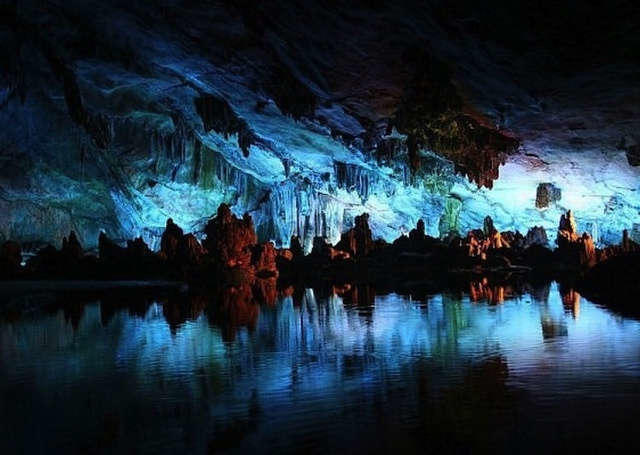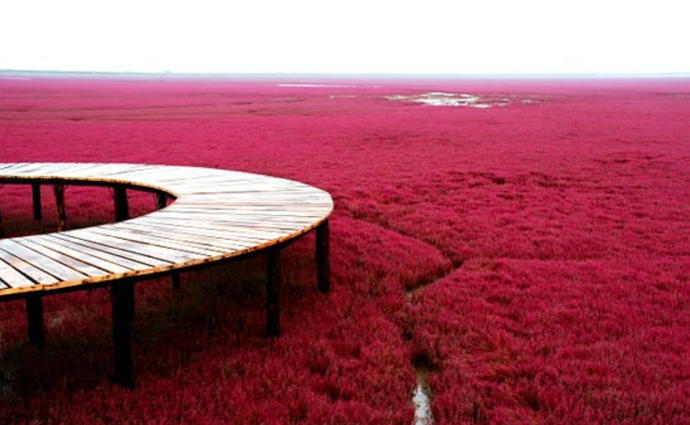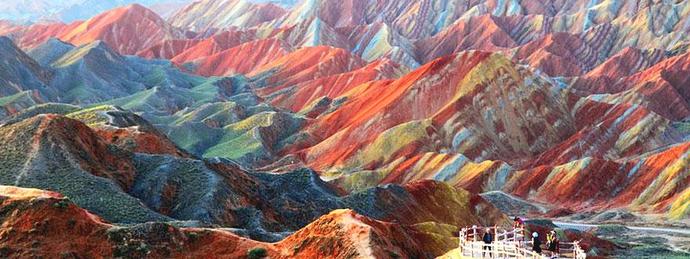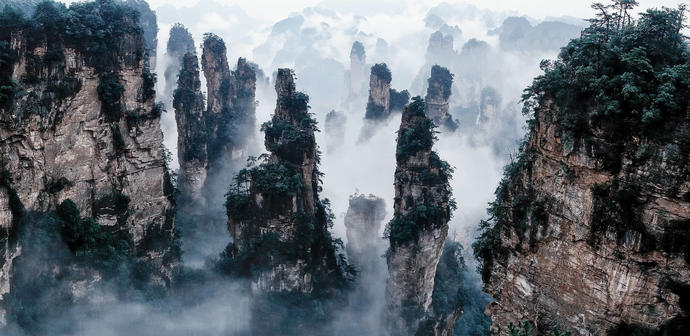Our world is full of natural wonders that seem too alien-like to actually exist. From starry beaches, to pink lakes, and crooked trees, it is quite mind-blowing that some of these things occur right here on our planet.
But, you don't have to take a rocket ship to outer space to do some extraterrestrial sight-seeing. Let's take a look at some outrageous places that are available right here on planet Earth.
Starry Beach of Maldives

This beach is real, not a make believe scene of a Disney movie. The small glowing dots of light are due to the microscopic organisms called bioluminescent phytoplankton, or scientifically known as Lingulodinium polyedrum.
Image via design taxi
Glow Worm Cave in Waitomo, New Zealand

This cave's alien luminescence is caused by the glow worm, or Arachnocampa luminosa, a species of worm native to New Zealand. Hundreds of thousands of the tiny creatures used their bioluminescence to make the cave have an unmistakeable glow.
Image via Roadtrippers
Fingal's Cave, Scotland

The angular columns of this cavern seem man-made, but that isn't the case at all. According to some theories, Fingal's Cave is formed from hexagonally jointed basalt columns within a Paleocene lava flow, similar in structure to the Giant's Causeway in Northern Ireland and those of nearby Ulva.
Image via flickr
Red Beach in Panjin, China

No, this is not the surface of Mars. This beach's strange colored grass is caused by the sueda species, one of the view species of grass that can thrive in highly alkaline soil. In it's early stanges of life, it begins as a pinkish shade of red, and, when fully grown, this pinkish-red changes to a deep red.
Image via citizensoffashion
The Schwarzwald (Black Forest) in Germany

The Black Forest's eerie vibe at night has kept Germany on it's toes for centuries. Even though it is creepy at times, it is very, very beautiful. The night sky gives the forest a stunning glow.
Image via ejazatcroup.com
Antelope Canyon in Arizona, USA

The maginficent swirls and lines on the canyon's sides makes it look almost like an extraterriestrial landform, but it's not. This canyon dwells in the United States. Millions of years of errosion of the Navajo sandstone gave the rocks and vally sides it's alien-like marks. Flash floods have carved the canyon, and they to this very day continue to happen.
Image via horseshoe bend
Lake Retba (Lac Rose, Pink Lake) in Senegal

Who doesn't want to take a dip in a bright pink lake? I do! Lake Retba, or Lac Rose, is named for it's pink waters, which is due to Dunaliella salina algae and is known for its high salt content, which can be up to 40% in some areas. The water is so dense with salt that it will cause you to float at times. Also, the salty lake does not support many life forms, as it is obviously very, very salty.
Image via reversehomesickness
Lençóis Maranhenses National Park in Brazil (Sand dunes)

Looking straight out of a sci-fi movie, this park's sand dunes have been it's main attraction for years. They have even sparked urban legend. According to local folklore, the region was inhabited by Caeté Indians, who woke up one day to find their town covered by sand. Today, the park serves as a sanctuary for the local ecology wildlife.
Image via 1ms.net
Door to Hell in Derweze, Ahal Province, Turkmenistan

No, this is not an actual door to eternal suffering. The "hell hole" is noted for its natural gas fire which has been burning continuously since it was lit by Soviet petroleum engineers in 1971. Since then, it has never ceased to stop burning. The natural gas that occurs at the site may be the reason to it's nonstop fury.
Image via ggwallpaper
Zhangye Danxia Landform, China

Across the Danxia landscape zone, a motif of red rocky outcrops resemble weird and wonderful shapes like castles, cones, towers ; as well as humans, creatures, birds and beasts. They were even given the name "rainbow mountains" due to the spectacular hues of colors on their surface. According to the experts, Danxia was formed by the erosion of red sandstone, forming isolated peaks and steep stratified outcrops. Its special geological structure, combined with long-term desert conditions , freeze-thaw peeling, and wind and water erosion gave rise to its present appearance.
Image via hepingshijie
Salar de Uyuni, Bolivia

This beautiful place is known as the world's largest salt flat at 10,582 square kilometers (4,086 sq mi). The salar is composed of a salt surface crust overlying brine saturated sediments such as sodium chloride (table salt), lithium chloride and magnesium chloride. These minerals and salts give the flat it's mirror-like properties.
Image via thehigherlearning.com
Mendenhall Ice Caves in Coast Range, Juneau Borough, Alaska, United States

It almost looks like the landscape of an alien planet. This ice cave was formed due to the water forming into ice, which created weird and unusual shapes with it. Due to it's breathtaking beauty, it has been a popular tourist attraction for people willing to head to Alaska.
Image via contest.thesca.org
Stone Forest (Shilin) in China

A forest of stone seems a little far-fetched, doesn't it? The limestone formations of the Shilin have been a popular tourist attaction for ages. The tall rocks seem to fall to the ground in the manner of stalagmites, with many looking like petrified trees thereby creating the illusion of a forest made of stone.
Image via tripping.com
Tulip Fields in the Netherlands

Sping time in the Netherlands marks the time of beautiful rainbow fields of flowers.From the end of March until the mid of May the flowers in the bulb fields go into bloom. Due to the weather's unpredictibility, it's hard to tell when it may happen.
At the end of March the "crocus season" starts. The daffodils and early and small tulips are next, from the beginning of April. From mid-April the daffodils and the hyacinths bloom. Finally, from mid April until the first week in May the tulips show off their glorious colors.
Image via jlaya002
The Windswept Trees at Slope Point, New Zealand

Slope Point is located at the southeastern tip of New Zealand. The area is constantly battered with harsh cold winds that come up from Antarctica. The weather is so relentless, that the trees there are deformed and twisted, forever warped along the direction that the winds blow. Today, the land is prodominately used for sheep farming. Aside from a few sheep and a few huts that nobody uses, no humans or animals live there.
Image via amusingplanet.com
Tianzi Mountains in China

The oddly shaped mountians stand up straight and touch the sky, and are a beautiful sight to behold. The Tianzi Mountains were formed from quartz sandstone over 400 million years ago because of the intermittent rising of the crust for 2 million years. The geological formation belongs to the "New Cathaysian" tectonic system.
Image via autographer.com
Coastal Potholes in California, USA

The formation of these potholes is a geological phenomenon. They're formed by the circular depressions found on wave cut platforms. They are formed in the rocky channel of a turbulent stream. They are further enlarged by the constant the motion of waves and the abrading action of pebbles. Groundwater also plays a significant role in the creation and sustenance of these potholes. Other natural occurrences, such as climate, temperature, wind, and (though somewhat indirectly) gravity also plays a major role in coastal processes.
Image via californianaturescapes
Underwater River in Cenote Angelita, Mexico

A river underwater? How can that be? From above, it looks like an ordinary old hole. The river comes into play if you go down deep enough, and you'll soon discover that it has a current! How does this happen? Angelita is a cenote, which is a deep sinkhole formed from the collapse of limestone bedrock that exposes groundwater underneath. Overtime, the cenote becomes filled with fresh water and rainwater, which meets the exposed salty water. The different densities causes the two waters to overlap, and the result is a river that flows underwater. The photo looks like any ordinary nighttime shot of a river, but it is actually underwater, and it's amazing.
Image via Huffington Post
Playa Del Amor (Hidden Beach) in Mexico

How does a beach exist in a crater surrounded by plant life? Playa Del Amor, more commonly known as the Hidden Beach, is a structure of one of the Marieta Islands, located west of Puerto Vallarta, Mexico, at the mouth of Banderas Bay. It is rumored that the hole revealing the Hidden Beach was a result of bombings. The Marieta Islands have always been uninhabited, leaving them vulnerable to be used by the Mexican Government. In the early 1900s, the government began using the islands as military testing sites. Test bombs are the known cause for many caves and rock formations on the island, possibly including the Hidden Beach.
The beach is not easily accessible, and you can only reach it through a long water tunnel that connects the beach to the Pacific Ocean.There is approximately six feet of space above sea level, so tourists can reach the beach by swimming or kayaking. The islands are still uninhabited, but are frequently visited by tourists who come to enjoy the diverse marine wildlife and the unique tropical Eden of Playa Del Amor.
Image via carlosmedliablog
Crooked Forest (Krzywy Las) outside of Nowe Czarnowo, West Pomerania, Poland

What could have caused this forest's oddly-shaped trees? This grove of about 400 pine trees was planted in the 1930's, when the grove's location was still within the German province of Pomerania. It was once believed that a human tool of some sort was used to make the trees grow in this way, but the method and motivation behind it is not currently known. It has also been believed that the trees may have been deformed to make naturally-formed timber to be used for furniture and boat-building. Others surmise that a snowstorm could have knocked the trees like this, but to date nobody knows what really happened to these pine trees. Nobody really knows why the trees here grow like this. Today, it is a popular tourist attraction.
Image via amusingplanet.com
Which one of these fantastic places would you love to visit one day? Which one of these places seems creepy and it just steers you away from it? Which one of these places was your favorite? Least favorite?
I hope you enjoyed reading. :)
 Holidays
Holidays  Girl's Behavior
Girl's Behavior  Guy's Behavior
Guy's Behavior  Flirting
Flirting  Dating
Dating  Relationships
Relationships  Fashion & Beauty
Fashion & Beauty  Health & Fitness
Health & Fitness  Marriage & Weddings
Marriage & Weddings  Shopping & Gifts
Shopping & Gifts  Technology & Internet
Technology & Internet  Break Up & Divorce
Break Up & Divorce  Education & Career
Education & Career  Entertainment & Arts
Entertainment & Arts  Family & Friends
Family & Friends  Food & Beverage
Food & Beverage  Hobbies & Leisure
Hobbies & Leisure  Other
Other  Religion & Spirituality
Religion & Spirituality  Society & Politics
Society & Politics  Sports
Sports  Travel
Travel  Trending & News
Trending & News
Most Helpful Opinions